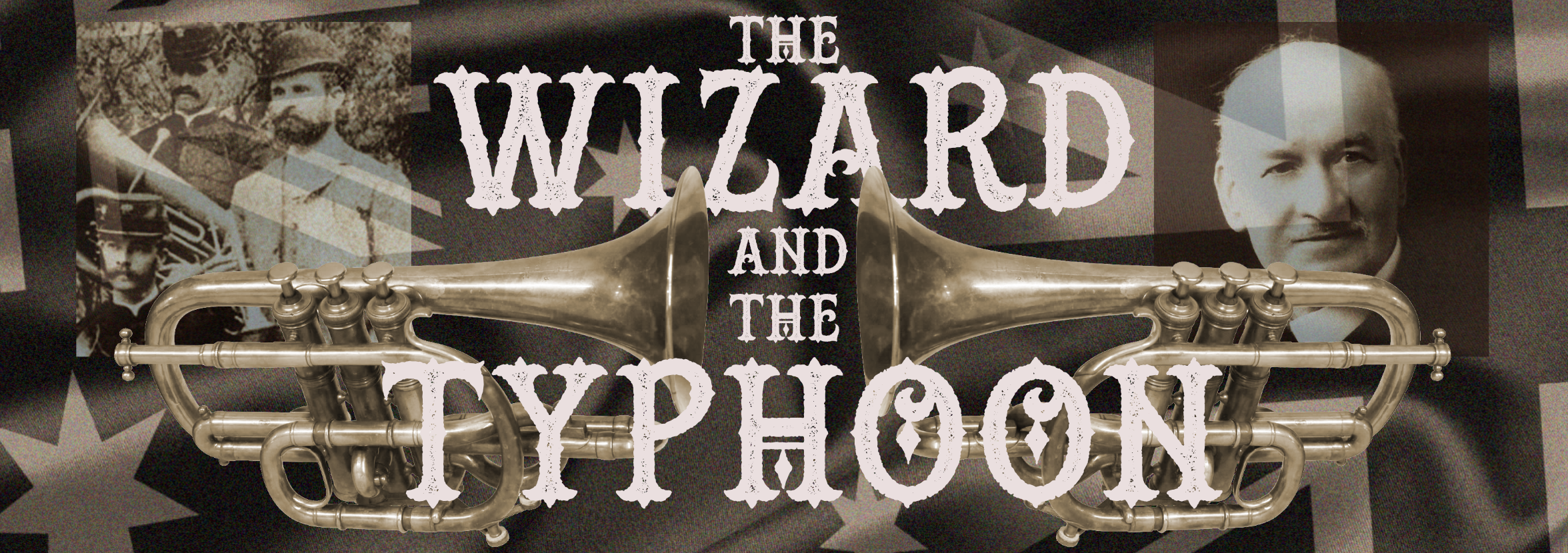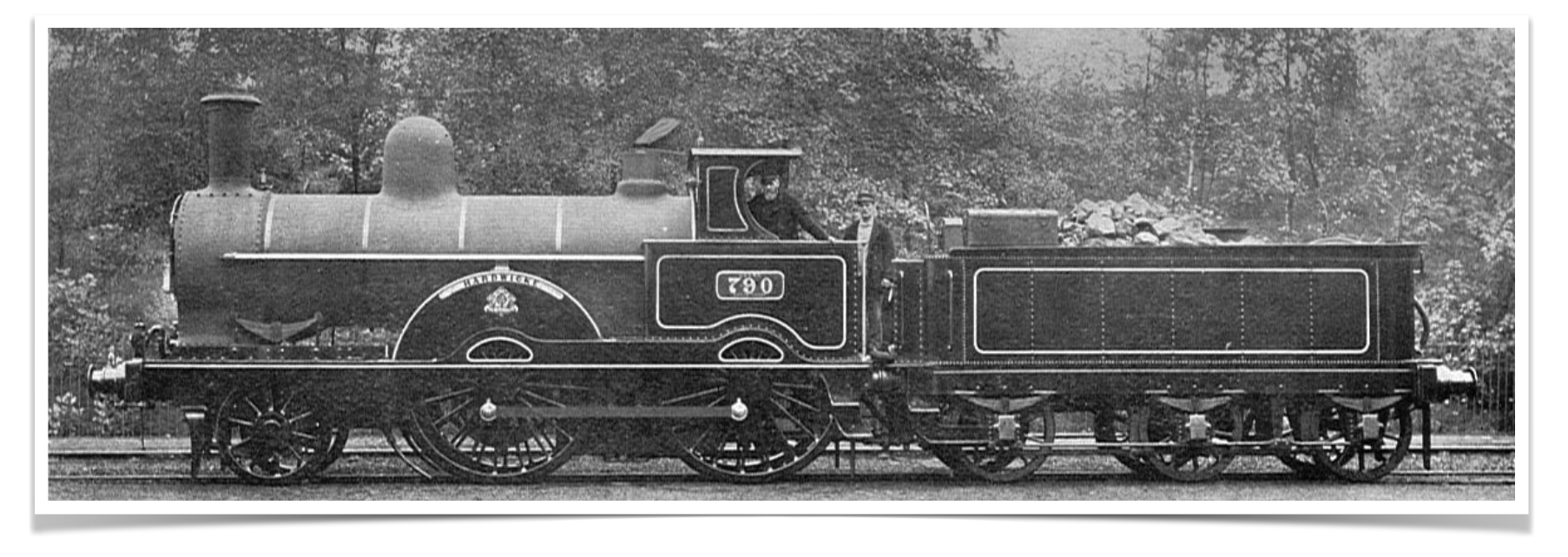When the group met on Monday and we were discussing the possible reasons why composition titles were chosen one of us, Brian to be precise, tabled a theory that perhaps, with George Allan having worked in railway engineering, some of his composition titles were influenced by the names of locomotives.
It’s a very tempting theory. It’s most likely that a composer of that time would have had to have been exposed to something, an object or experience, to have thought “that’d make a grand name for a march”. It would be easy to think that these Victorian manual workers would have had a limited exposure to the world so would have had a limited range of inspiration, but I’m not so sure. The workers at the Shildon works would have had access to the Mechanics’ Institute on Station street, with a wealth of periodicals, many of which would have been illustrated. The railway itself would give these people access to the coast, cities and other places. There would have been books to hand. Also being bandsmen the likes of George Allan and T E Bulch would have experienced probably more travel than most, going to contests.
That said, I thought Brian might be on to something. Many of the George Allan titles would indeed have been great names for locomotives. Certainly worth exploring further. So I did a quick comparative check of George Allan titles against a fairly extensive list of named UK locomotives. I omitted some that really didn’t look like a locomotive name, but still went through a fairly extensive subset. What I found is outlined in the list below.
I think it’s an inconclusive outcome, but there was one surprise in there, whether it be coincidence or otherwise. 21 of the 72 names I checked did match the name of a locomotive in the UK that would have been around in George Allan’s day – though none of them were built for the North Eastern Railway or the London North Eastern Railway where George would have had the most exposure. Many were connected with the South West so probably unlikely he would have seen them unless in a magazine.
However there were a group of 4 connected to the London North Western Railway (LNWR) that were all seemingly built at Crewe and from the same class of locomotive. These being; “Balmoral”, “Phantom”, “Wizard” and “General” which are all 2-4-0 LNWR Precedent Class locomotives (or Jumbo class) just like the ‘Hardwicke’ I used in the photograph for this post (which incidentally is preserved at York Railway Museum). Furthermore two others “Raleigh” and “Florence” were built at the same works as part of the LNWR Improved Precedent Class making six locomotives in total from the same works with a matching name to an Allan piece.
It would be an absolutely acceptable coincidence for as we said many of the George Allan titles would almost certainly be great names for locomotives anyway, or at least typical of locomotive names. But might it be more than a coincidence?
This may be something we never quite know
Findings in detail:
- Ariona – nothing found
- Ashbourne – nothing found
- Balmoral – there were two – one built in Darlington but not until 1948 – one in 1897 in Crewe for the LNWR
- Battle Abbey – nothing found – there was a Bath Abbey built for the GWR
- Belmont – nothing found but there was a Belmont Hall built for the GWR
- Binchester – nothing found
- Blytheville – nothing found
- Boscombe – nothing found
- Bravura – nothing found
- Chester – there was a Chester built for the GWR in 1866 – probably never seen in the NE though
- Collier – nothing found
- Convention City – nothing found
- Cyclone – nothing found
- Darlington – there was a Darlington but not built till 1936
- Delight- nothing found
- Diomed – nothing found
- Diplomat – nothing found
- Eclipse – there was an Eclipse built in 1840 for the GWR and one built in 1913 for the LNWR
- Elmville – nothing found
- Enchantment – nothing found
- Europa – there was a Europa built in 1853 for the GWR
- Eveline – nothing found
- Everest – nothing found
- Eventide – nothing found
- Federation – nothing found
- Forward – nothing found
- Florence – There was a Florence built in 1851 for the GWR, and one built in 1891 for the LNWR
- Gabriani – nothing found
- Gale, The – nothing found
- General, The – there was a loco called General which was built for the LNWR in 1878
- Glory, The – nothing found
- Granville – there was a Granville built for the SR – unclear when
- Humber – there was a Humber built for the GWR in 1857
- Imperioso – nothing found
- Impetus – nothing found
- Jupiter – there were several Jupiters, one for the GWR in 1841, another for the GWR later, another for the L& BR in 1840, another for the LNWR in 1903, another for the SDR (Not the S&DR) in 1876
- King Edward – nothing found – there are King Edwards but all numbered – e.g. King Edward VI
- Knight Templar – – there was a Knight Templar for the GWR – date unknown
- Maestro – nothing found
- Rustica – nothing found
- Rusticus – nothing found
- Lefebvre – nothing found
- Larkhill – nothing found
- Lonsdale – nothing found
- Lunedale – nothing found
- Lyndhurst – nothing found
- Mechanic – nothing found
- Moonbeam – nothing found
- Nevada – nothing found
- Niobe – nothing found
- Olicana – nothing found
- Operatic – nothing found
- Pendragon – there was a Pendragon for the BR but not till 1955, also another undated for the SR
- Penelope – nothing found
- Phantom – there was a Phantom built for the LNWR in Crewe in 1894
- Pioneer – there were several Pioneers – one in 1875 built at Barclay, one for the BP and GV, one for the GWR in 1861 and one for the LNWR in 1888 built in Crewe
- Raby – nothing found – though there was a Raby Castle undated
- Raleigh – there was a Raleigh built in Crewe in 1888 for the LNWR and another for the LMS undated
- Red Cross – nothing found
- Repulse – there was a repulse for the LMS undated
- Rosarita – nothing found
- Runaway – nothing found
- Senator – there was a Senator built in Crewe in 1904
- Shawville – nothing found
- Silverdale – nothing found
- Silver King – there was a Silver King on the LNER
- Traveller – there was a Traveller built for the LNWR in 1911
- Vigilant – nothing found
- Virgin Island – nothing found
- Waltham – nothing found
- Waverley – there was a Waverley built for the LNWR at Crewe in 1905, and another for the GWR in 1855
- Wizard – there was a Wizard built in 1895 in Crewe for the LNWR

